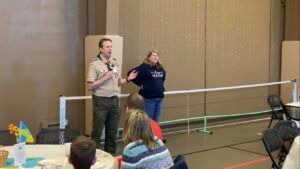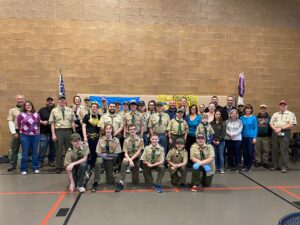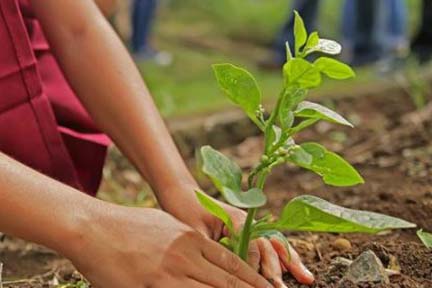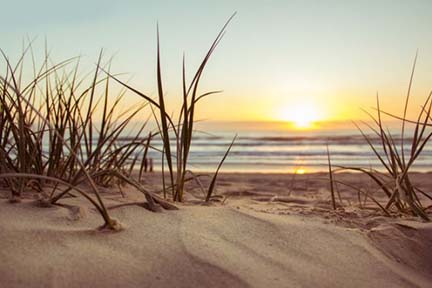
Whitmer Unveils MI Healthy Climate Plan

Gov. Whitmer Unveils MI Healthy Climate Plan to Create Good-Paying Jobs, Protect Air and Water Plan outlines path to carbon neutrality by 2050, interim steps to take by 2030 including more clean energy, electric vehicle charging infrastructure, land & water conservation
TRAVERSE CITY, Mich. — Governor Gretchen Whitmer today released the MI Healthy Climate Plan, a roadmap for Michigan to achieve economy-wide carbon neutrality by 2050 with interim 2030 goals. Governor Whitmer joined Liesl Clark, Director of the Michigan Department of Environment, Great Lakes, and Energy (EGLE), business owners, tribal leaders, and students at a large solar array in Traverse City to announce the plan. The MI Healthy Climate Plan proposes climate action that would create tens of thousands of clean-energy jobs, spur economic development and innovation, protect clean air and water, and improve public health. The MI Healthy Climate Plan builds off the leadership of tribal communities and cities and town across Michigan, in addition to the private sector.
“Michigan has been impacted by climate change, from a polar vortex and historic floods to dam breaks and week-long power outages. The MI Healthy Climate Plan identifies actions we can take to address climate change head-on, lower costs for Michiganders, ensure every Michigan worker has a good-paying, sustainable job, and every family has clean air, water, and a home powered by clean, reliable energy,” said Governor Whitmer. “If we follow the steps outlined in the plan and collaborate with public and private sector partners, we can build a Michigan where every Michigander has clean air to breathe, clean water to drink, and access to healthy, affordable local food. Today, we are positioning Michigan to become the global center of clean energy innovation where workers can get good-paying jobs, from those that don’t require a college degree to careers in advanced engineering and science. We can protect our beautiful public lands and majestic Great Lakes, driven by our unyielding belief in a brighter future.”
“This is a uniquely Michigan plan. It was shaped by a multitude of Michiganders with varied perspectives on climate change,” said Liesl Clark, EGLE Director. “We heard from environmental justice, public transit, local food, and climate action advocates; an array of business and labor leaders; academic experts and local government officials; and concerned residents of all political persuasions and walks of life. The resulting MI Healthy Climate Plan will be a game-changer for Michigan’s economy and environment. It is a bold plan that a broad cross-section of Michiganders can rally around.”
“One of Michigan’s greatest assets is its location advantage, including our access to water resources of the Great Lakes. The MI Healthy Climate Plan helps us minimize that location advantage by ensuring that we are intentional about preserving that advantage for future generations. At MEDC, we are focused on attracting and growing businesses that not only create jobs but also demonstrate a commitment to sustainable practices to ensure long-term economic opportunity and well-being for all Michiganders,” said Michigan Economic Development Corporation CEO Quentin L. Messer, Jr. “In 2021, Michigan was recognized as a top state in sustainable development practices by Site Selection magazine, affirming Michigan’s commitment to green energy practices and demonstrating our competitive advantages when it comes to climate issues. Michigan will be a climate winner and this plan is an important part of the winning playbook.”
MI Healthy Climate Plan In September 2020, the Governor committed Michigan to achieving economy-wide carbon neutrality no later than 2050. The goal included interim reductions of 28% by 2025, 52% by 2030, and maintaining net negative greenhouse gas emissions (GHG) after 2050. Concurrently, she charged EGLE, through its Office of Climate and Energy, to work alongside the Council on Climate Solutions to develop the MI Healthy Climate Plan, a state action plan to reduce GHG emissions and transition toward economy-wide carbon neutrality.
The plan positions Michigan as a climate action leader and focuses on actions to spur economic development and create good-paying jobs, lower energy and transportation costs for working families and businesses, work towards energy independence, mitigate the worst impacts of climate change, improve public health, and protect natural resources and wildlife.
The MI Healthy Climate Plan identifies what needs to happen for Michigan to reach carbon neutrality by 2050 with a prioritization on actions from now until 2030. The plan’s recommendations fall around 6 pillars:
Leading on Climate, Creating Good-Paying Jobs, Growing Michigan’s Economy Since taking office, Governor Whitmer has taken action to tackle climate change head-on and grow Michigan’s economy. She has committed to powering all State of Michigan facilities with 100% renewable energy by 2025 and attracted battery and electric vehicle manufacturing investments from automakers, who have added 21,600 good-paying auto jobs in Michigan since the governor took office. She has signed bipartisan budgets investing millions of dollars in clean energy improvements and recently proposed a budget investing over half a billion dollars in climate action, including clean energy improvements for small businesses and families, a rebate to lower the cost of electric vehicles, grants to build climate-resilient infrastructure, and funds to expand our electric vehicle charging network.
Recently, Michigan state senators Polehanki and McCann introduced bills to establish a $500 charging equipment and $2,000 electric vehicle rebate to knock off nearly $10,000 off the price of an electric vehicle when combined with the federal tax credit.
The Whitmer-Gilchrist Administration’s water, environment, and climate accomplishments can be found here, and mobility and automotive accomplishments can be found here.
Quotes from Members of the Council on Climate Solutions “The Michigan Healthy Climate Plan is a bold first step toward mitigating the worst impacts of climate change while advancing opportunity, justice, and health. We have a long way to go, but this plan moves us quickly to get onto the right path,” said Phil Roos, CEO of Great Lakes GrowthWorks and Co-Chair of the Council on Climate Solutions. “Kudos to Governor Whitmer for her leadership in setting goals that match the magnitude of the challenge, and to her and EGLE Director Clark for putting in place a collaborative process that gave voice to an incredibly wide range of perspectives. That process has led to a plan that is Michigan-centric, positioning our state as a leader in the clean economy of the future, as a healthy refuge in a rapidly warming climate, and as leaders in advancing opportunity and justice for all as we make this important and critical transition to a decarbonized economy and healthier life for all the citizens of our state.”
“Hemlock Semiconductor’s core focus on driving sustainability and combating climate change by reducing the carbon footprint of our products and manufacturing processes is aligned with Governor Whitmer’s MI Healthy Climate Plan,” said Steven Holty, Hemlock Semiconductor Sustainability Leader and Co-Chair of the Energy Intensive Industries Workgroup for the Council on Climate Solutions. “Lowering the cost of clean energy for industrial users and delivering carbon-neutral fuels by 2050 will help create a more competitive business environment in Michigan and support HSC’s continued growth and success as the nation’s leading manufacturer of ultra-low carbon polysilicon for the semiconductor and solar energy industries. We also commend Gov. Whitmer for her plan to identify and prioritize low-carbon procurement opportunities for the State of Michigan. This action sends an important signal that Michigan is serious about leveraging the state’s considerable purchasing power to achieve carbon neutrality.”
“Ford is leading the electric vehicle revolution, investing more than $50 billion in electric vehicles through 2026, committing to carbon neutrality no later than 2050, and bringing exciting, all-electric versions of America’s most popular vehicles to market, including the all new, all electric F-150 Lightning,” said Cynthia Williams, Global Director of Sustainability, Homologation and Compliance at Ford and member of the Council on Climate Solutions. “We’re transforming our business and going all-in on electrification because we know it’s good for people and the planet. With investments in world-class facilities, such as the Rouge Electric Vehicle Center in Dearborn, we’re proud to be leading America’s transition to electric vehicles, creating jobs, and ushering in a new era of clean, carbon-neutral manufacturing from our home right here in Michigan. We are proud to see a plan for bold climate action in Michigan.”
“I’m grateful for my chance to help with the MI Healthy Climate Plan. As someone who has worked in Tribal environmental and natural resource management for nearly thirty years, I am glad to see such a great effort towards climate change issues in our State,” said Frank William Beaver, Director of the Natural Resources Department for the Little River Band of Ottawa Indians and member of the Council on Climate Solutions. “Over the years I’ve seen impacts such as the warming of our lakes and streams, the deterioration and failing of our dams, and an increased risk of flooding due to the loss of wetlands. From the fish and wild game across our state to the Mnoomin (wild rice) that grows on our waters, and the lakes and trails that we enjoy, we all love and depend on these natural systems. I know that through this Plan that we can reduce impacts to these systems now and in the future.”
“The MI Healthy Climate Plan has the potential to help speed up our state’s shift to clean energy in a way that helps everyone,” said Derrell Slaughter, Michigan Clean Energy Advocate at Natural Resources Defense Council (NRDC) and Secretary of the Council on Climate Solutions. “The implementation of the plan will increase renewable energy in Michigan, create more access for clean energy and clean transportation, and get Michigan off coal while lowering costs for working families and protecting our natural resources and public health. We must now work to implement these recommendations to create a healthier Michigan. The time is now to tackle the climate crisis head on and this plan shows us how the Great Lakes State can do its part.”
“Since our founding over 110 years ago along the shores of Lake Michigan in Benton Harbor, improving life at home has been at the heart of Whirlpool Corporation,” said Ron Voglewede, Director of Sustainability, Whirlpool Corporation, and member of the Council on Climate Solutions. “Fulfilling our vision requires us to think of not only the four walls around us and the communities in which we live, but of the planet that sustains us. We are proud to work in collaboration with Governor Whitmer and several other stakeholders to help all Michiganders have a home that can save on energy costs, to support clean energy solutions, and to help ensure that Michigan continues to lead in the transition to a low carbon economy.”
“This is a thoughtful plan that will both advance a stronger economic future for workers in Michigan and protect the environment so generations to come will be able to enjoy it,” said Jim Harrison, Utility Workers Union of America (UWUA) director of renewable energies and advisor on the Council on Climate Solutions. “We commend Governor Whitmer for taking a worker-inclusive approach to meeting the state’s carbon emission reduction goals. We appreciate the opportunity to share input on behalf of our members and look forward to implementing this plan to maximize its effectiveness.” |

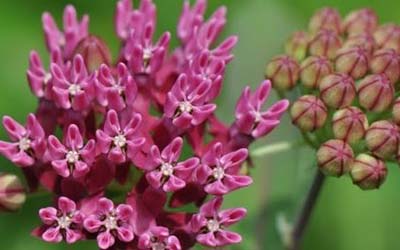


 Want to see more pictures like this, taken by Michigan state parks photo ambassador
Want to see more pictures like this, taken by Michigan state parks photo ambassador  One of the best ways to help the planet is to think local. We are all part of an ecosystem, and that includes where and how we get our food. Try growing your own food or buying it directly from local farmers – or, head out into the wild and forage or hunt some food yourself!
One of the best ways to help the planet is to think local. We are all part of an ecosystem, and that includes where and how we get our food. Try growing your own food or buying it directly from local farmers – or, head out into the wild and forage or hunt some food yourself!
 Foraging is a great way to supplement your diet, but make sure you only take what you need; sustainable foraging ensures those delicious plants stay healthy and fruit-bearing for others and the future.
Foraging is a great way to supplement your diet, but make sure you only take what you need; sustainable foraging ensures those delicious plants stay healthy and fruit-bearing for others and the future.
 Our pollinators are facing a lot of challenges, but you don’t need a yard to help them. Whether it’s a backyard patio, an apartment balcony or even a high-rise roof, you can create a little slice of heaven by planting native wildflowers to give our insect neighbors a boost. If you have land, consider planting a pollinator garden or pollinator habitat strips, especially if you have a farm.
Our pollinators are facing a lot of challenges, but you don’t need a yard to help them. Whether it’s a backyard patio, an apartment balcony or even a high-rise roof, you can create a little slice of heaven by planting native wildflowers to give our insect neighbors a boost. If you have land, consider planting a pollinator garden or pollinator habitat strips, especially if you have a farm.
 Many important pollinators, like the Karner blue butterfly, the rusty patched bumblebee and the monarch butterfly, are facing extinction due to habitat destruction, climate change, pollution and pesticide use. Other pollinators, such as
Many important pollinators, like the Karner blue butterfly, the rusty patched bumblebee and the monarch butterfly, are facing extinction due to habitat destruction, climate change, pollution and pesticide use. Other pollinators, such as  Whether we’re in school or not, humans are lifelong learners. DNR educators across the state provide great programs throughout the year for anyone looking to expand their horizons.
Whether we’re in school or not, humans are lifelong learners. DNR educators across the state provide great programs throughout the year for anyone looking to expand their horizons.
 Did you know that there are over 300
Did you know that there are over 300  Did you know that many of the plants that are most invasive in local natural areas originally arrived as ornamental garden plants? You can prevent the introduction and spread of invasives by purchasing plants at local nurseries and through landscapers that have committed to not selling high-threat invasive ornamental plants. Find out more at the Northwest Michigan Invasive Species Network’s
Did you know that many of the plants that are most invasive in local natural areas originally arrived as ornamental garden plants? You can prevent the introduction and spread of invasives by purchasing plants at local nurseries and through landscapers that have committed to not selling high-threat invasive ornamental plants. Find out more at the Northwest Michigan Invasive Species Network’s 
